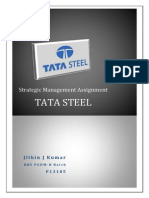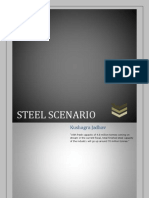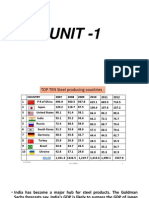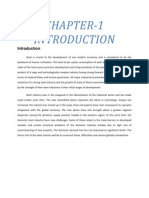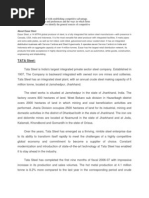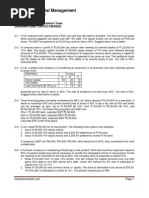Assignment 1
Assignment 1
Uploaded by
Niranjan MoreCopyright:
Available Formats
Assignment 1
Assignment 1
Uploaded by
Niranjan MoreCopyright
Available Formats
Share this document
Did you find this document useful?
Is this content inappropriate?
Copyright:
Available Formats
Assignment 1
Assignment 1
Uploaded by
Niranjan MoreCopyright:
Available Formats
Assignment 1.
Name : Niranjan More Roll No : 127
Michael Porters Five Forces Model Steel industry Introduction India occupies a central position on the global steel map, with the establishment of new state-of-the-art steel mills, acquisition of global scale capacities by players, continuous modernisation and upgradation of older plants, improving energy efficiency and backward integration into global raw material sources Steel production in India has increased by a compounded annual growth rate (CAGR) of 8 percent over the period 2002-03 to 2006-07. Going forward, growth in India is projected to be higher than the world average, as the per capita consumption of steel in India, at around 46 kg, is well below the world average (150 kg) and that of developed countries (400 kg). Indian demand is projected to rise to 200 million tonnes by 2015. Given the strong demand scenario, most global steel players are into a massive capacity expansion mode, either through brownfield or greenfield route. By 2012, the steel production capacity in India is expected to touch 124 million tonnes and 275 million tonnes by 2020. While greenfield projects are slated to add 28.7 million tonnes, brownfield expansions are estimated to add 40.5 million tonnes to the existing capacity of 55 million . Porters Five force analysis. 1. Entry Barrier:- High a) Capital Requirement: Steel industry is a capital intensive business. It is estimated that to set up 1 mtpa capacity of integrated steel plant, it requires between Rs 25 bn to Rs 30 bn depending upon the location of the plant and technology used.
b) Economies of scale: As far as the sector forces go,scale of operation does matter. Benefits of economies of scale are derived in the form of lower costs, R& D expenses and better bargaining power while sourcing raw materials. It may be noted that those steel companies, which are integrated, have their own mines for key raw materials such as iron ore and coal and this protects them for the potential threat for new entrants to a significant extent. c) Government Policy: The government has a favorable policy for steel manufacturers. However, there are certain discrepancies involved in allocation of iron ore mines and land acquisitions. Furthermore the regulatory clearances and other issues are some of the major problems for the new entrants.
2. Competition:- High The steel industry is truly global in terms of through aggressive exports. Steel, being a commodity it is, branding is not differentiation between competing products. Presence of a large number of players in the unorganized sector. High Competition due cost differentiation from companies like Adhunik , MUSCO, Kalyani Steels, JSW , Viraj It is medium in the domestic steel industry as cheaper products does exist. demand still exceeds the supply. India is a net importer of steel. However, a threat from dumping of common and there is little competition with large producing countries like China significantly influencing global prices
3. Bargaining power of suppliers: High The bargaining power of suppliers is low for the fully integrated steel plants as they have their own mines of key raw material like iron ore, coal for example Tata Steel. However, those who are non-integrated or semi integrated has to depend on suppliers. An example could be SAIL, which imports coking coal. Globally, the Top three mining giants BHP Billiton, CVRD and Rio Tinto supply nearly two-thirds of the processed iron ore to steel mills and command very high bargaining power. In India too, NMDC is a major supplier to standalone and nonintegrated steel mills. 4. Threat of substitutes: Low Plastics and composites pose a threat to Indian steel in one of its biggest markets automotive manufacture. For the automobile industry, the other material at present with the potential to upstage steel is aluminium. However, at present the high cost of electricity for extraction and purification of aluminium in India weighs against viable use of aluminium for the automobile industry. Steel has already been replaced in some large volume applications: railway sleepers (RCC sleepers), large diameter water pipes (RCC pipes), small diameter pipes (PVC pipes), and domestic water tanks (PVC tanks). The substitution is more prevalent in the manufacture of automobiles and consumer durables
5. Bargaining power of Customers: Mixed Some of the major steel consumption sectors like automobiles, oil & gas, shipping, consumer durables and power generation enjoy high bargaining power and get favorable deals. However, small and retail consumers who are scattered and consume a significant part do not enjoy these benefits.
Conclusion Industry unattractive because of high compitition and high entry barriers.
You might also like
- B Plan Mobile SalonDocument4 pagesB Plan Mobile SalonShristi Gupta100% (2)
- A Nut Case Assignment 2Document2 pagesA Nut Case Assignment 2Priya Murmu33% (3)
- Syndicate 5 RodaMas GroupDocument34 pagesSyndicate 5 RodaMas GroupJonathan Febrian100% (2)
- A Study of Electronic Data Storage Steel Factory in Mumbai11Document71 pagesA Study of Electronic Data Storage Steel Factory in Mumbai11Thirupal Nk100% (3)
- Project Report On Comparative Analysis of Public and Private Sector Steel Companies in IndiaDocument48 pagesProject Report On Comparative Analysis of Public and Private Sector Steel Companies in IndiaHillary RobinsonNo ratings yet
- Steel Industry of BangladeshDocument3 pagesSteel Industry of BangladeshMISHUM RAHMAN100% (2)
- Tata Steel: Q1. Apply PESTLE, FIVE FORCES & SWOT Analysis On Following Tata BusinessDocument51 pagesTata Steel: Q1. Apply PESTLE, FIVE FORCES & SWOT Analysis On Following Tata BusinessAnsh AnandNo ratings yet
- Advantages of Registering A Holding Company in The PhilippinesDocument4 pagesAdvantages of Registering A Holding Company in The PhilippinesAIZA SALABANTE CALOYLOYNo ratings yet
- JSW - FInal - 2Document10 pagesJSW - FInal - 2Devika SinghaniaNo ratings yet
- National Steel Policy 2017Document31 pagesNational Steel Policy 2017Jagdish AroraNo ratings yet
- Steel and Iron Industry AnalysisDocument7 pagesSteel and Iron Industry AnalysisRhutika KuwarNo ratings yet
- Report On Steel IndustryDocument15 pagesReport On Steel Industrysiddhesh4788No ratings yet
- SWOT Analysis For JSW SteelDocument8 pagesSWOT Analysis For JSW SteelPankaj Khannade75% (4)
- A Study of Electronic Data Storage Steel Factory in Mumbai11 150218034403 Conversion Gate02Document51 pagesA Study of Electronic Data Storage Steel Factory in Mumbai11 150218034403 Conversion Gate02NIKHIL CHAUHANNo ratings yet
- Logistics of Indian Steel IndustryDocument28 pagesLogistics of Indian Steel Industryvishalchandu86% (7)
- Capstone Deliverable3 Group31Document8 pagesCapstone Deliverable3 Group31Anju PuthanamkuzhiNo ratings yet
- Problem and Prospect of LSIDocument14 pagesProblem and Prospect of LSIakky.vns2004No ratings yet
- Strategic Management - Tata SteelDocument11 pagesStrategic Management - Tata SteelJj KumarNo ratings yet
- CHAPTER 3 Steel Industry 12 Mini ProjectDocument18 pagesCHAPTER 3 Steel Industry 12 Mini ProjectMilkey PandeyNo ratings yet
- Unit-3 Iron and Steel Industry SWOT Analysis A. Strength: Page - 1Document50 pagesUnit-3 Iron and Steel Industry SWOT Analysis A. Strength: Page - 1Archana RajNo ratings yet
- Steel Scenario: Kushagra JadhavDocument12 pagesSteel Scenario: Kushagra JadhavKushagra JadhavNo ratings yet
- Precision Steel TubesDocument9 pagesPrecision Steel TubesRam KumarNo ratings yet
- Strategy Review - Tata SteelDocument20 pagesStrategy Review - Tata SteelKen SekharNo ratings yet
- Steel Making NotesDocument22 pagesSteel Making NotesVipin NandaNo ratings yet
- Porters Five Forces-Steel IndustryDocument4 pagesPorters Five Forces-Steel IndustrySwetabh2250% (2)
- Economics (Sree)Document45 pagesEconomics (Sree)steevejan541No ratings yet
- Indian Steel IndustryDocument23 pagesIndian Steel IndustryPoonam SanasNo ratings yet
- Problems of Iron and Steel Industry in India:: Swot Analysis StrengthDocument4 pagesProblems of Iron and Steel Industry in India:: Swot Analysis StrengthAnonymous hmd3jXd4No ratings yet
- Production and Consumption Trends in The Total Finished Steel Market (In Million Tonnes)Document6 pagesProduction and Consumption Trends in The Total Finished Steel Market (In Million Tonnes)Monish RcNo ratings yet
- Drgorad SM ProjectDocument10 pagesDrgorad SM ProjectDeepak R GoradNo ratings yet
- Iron and Steel in India Is Over 125 Year OldDocument7 pagesIron and Steel in India Is Over 125 Year Olddharun1193No ratings yet
- Report On IronDocument11 pagesReport On IronammoosNo ratings yet
- Iron and Steel Industry in IndiaDocument16 pagesIron and Steel Industry in IndiaAnonymous gQyrTUHX38100% (1)
- Steel Has An Oligopoly Market IDocument6 pagesSteel Has An Oligopoly Market Iarchana783No ratings yet
- Refractories industry in indiaDocument3 pagesRefractories industry in indiarajaNo ratings yet
- ChapterDocument6 pagesChapterMaria Sebastian ManjalyNo ratings yet
- Capstone Deliverable2 Group31Document11 pagesCapstone Deliverable2 Group31Anju PuthanamkuzhiNo ratings yet
- Sub: Strategic Management: Steel IndustryDocument13 pagesSub: Strategic Management: Steel IndustryRohit GhaiNo ratings yet
- Steel Industry Overview ReportDocument92 pagesSteel Industry Overview ReportAnkit SinghNo ratings yet
- Steel IndustryDocument21 pagesSteel IndustryBhupen YadavNo ratings yet
- Steel Industry in India: Project FinanceDocument32 pagesSteel Industry in India: Project FinanceSharvil Vikram Singh100% (1)
- Shishir 2.1 To 2.4Document4 pagesShishir 2.1 To 2.4Shishir KumarNo ratings yet
- Steel Industry IntroductionDocument8 pagesSteel Industry IntroductionAmitNo ratings yet
- Sail ProjectDocument69 pagesSail ProjectBhoomika SrivastavaNo ratings yet
- Steel IndustryDocument28 pagesSteel Industryrohitmahato10No ratings yet
- OTCM DriversDocument5 pagesOTCM Driverslikith.focus25No ratings yet
- Quantative Techniques - Ii Project ReportDocument18 pagesQuantative Techniques - Ii Project ReportArun Kumar SatapathyNo ratings yet
- Iron and Steel Industry in IndiaDocument10 pagesIron and Steel Industry in IndiaJordan SarasanNo ratings yet
- Industry Profile: Steel Industry Is Becoming More and More Competitive With Every Passing Day. During TheDocument19 pagesIndustry Profile: Steel Industry Is Becoming More and More Competitive With Every Passing Day. During Thevinay8464No ratings yet
- Future of Steel in IndiaDocument41 pagesFuture of Steel in IndiaSatish TrivediNo ratings yet
- Five Forces AnalysisDocument4 pagesFive Forces Analysisneekuj malikNo ratings yet
- Training Report 1 JindalDocument22 pagesTraining Report 1 JindalPoonam vaishnavNo ratings yet
- Nezone FinalDocument61 pagesNezone Finalvictor saikiaNo ratings yet
- Company Profile Presentation PDFDocument9 pagesCompany Profile Presentation PDFSakshi Singh RajputNo ratings yet
- Study On Steel Sector FINALDocument58 pagesStudy On Steel Sector FINALVivek BohraNo ratings yet
- Steel IndustryDocument14 pagesSteel IndustryRidhi BhanushaliNo ratings yet
- Steel TypeDocument15 pagesSteel TypeYadav KrishnaNo ratings yet
- Internship ReportDocument41 pagesInternship ReportPankaj KumarNo ratings yet
- TATA SteelDocument7 pagesTATA Steelshraddha_maheshwari6No ratings yet
- Industry and Company AnalysisDocument76 pagesIndustry and Company AnalysisAnsu MishraNo ratings yet
- Spot Welding Interview Success: An Introduction to Spot WeldingFrom EverandSpot Welding Interview Success: An Introduction to Spot WeldingNo ratings yet
- HFC Hydrogen Fuel Cell Cars: The Next Generation in Electric CarsFrom EverandHFC Hydrogen Fuel Cell Cars: The Next Generation in Electric CarsNo ratings yet
- Hand Book For Steel Structure Quality Control on SiteFrom EverandHand Book For Steel Structure Quality Control on SiteNo ratings yet
- ProblemSet2 SolutionsDocument3 pagesProblemSet2 SolutionsSimonNo ratings yet
- Capital Structure Question BankDocument5 pagesCapital Structure Question BankQuestionscastle FriendNo ratings yet
- Club Med A SumeetDocument2 pagesClub Med A SumeetsumeetkantkaulNo ratings yet
- 2 3 2017 ReceivablesDocument4 pages2 3 2017 ReceivablesMr. CopernicusNo ratings yet
- What Is Global Justice?: Declaration of Human Rights Reflect Efforts To Establish Globally Uniform MinimumDocument13 pagesWhat Is Global Justice?: Declaration of Human Rights Reflect Efforts To Establish Globally Uniform MinimumRimpa BhowmikNo ratings yet
- Topic 11 - FM For Agribusiness Financing The Agribusiness - Tools For Evaluating Operating DecisionsDocument40 pagesTopic 11 - FM For Agribusiness Financing The Agribusiness - Tools For Evaluating Operating DecisionsAn-nur HazirahNo ratings yet
- CCL Products Initiating Coverage Sep 14 EDEL PDFDocument35 pagesCCL Products Initiating Coverage Sep 14 EDEL PDFrohitkhanna1180No ratings yet
- Putting People First For The Organisation Success BilalDocument4 pagesPutting People First For The Organisation Success BilalbilalyasirNo ratings yet
- First Call (DreamPort)Document25 pagesFirst Call (DreamPort)Mann MannNo ratings yet
- Revision Question 2023.11.21Document5 pagesRevision Question 2023.11.21rbaambaNo ratings yet
- Statement Aug 2013Document10 pagesStatement Aug 2013berstuck100% (2)
- AddidasDocument4 pagesAddidasTauseef AhmadNo ratings yet
- Chap 5 ExerciseDocument2 pagesChap 5 ExerciseHồng PhongNo ratings yet
- D2531 Marketing-Toolbox en PPT2007-2010Document204 pagesD2531 Marketing-Toolbox en PPT2007-2010Mick Bunting100% (3)
- Eco201 Cheatsheet Summary Managerial EconomicsDocument5 pagesEco201 Cheatsheet Summary Managerial Economicswasif ahmedNo ratings yet
- Imitation JewelryDocument13 pagesImitation JewelryMehadiNo ratings yet
- ECON 209 Midterm Solutions - F23Document13 pagesECON 209 Midterm Solutions - F23Ali TNo ratings yet
- Intl MKG BSC NotesDocument65 pagesIntl MKG BSC NotesNgang PerezNo ratings yet
- Modern BakeryDocument14 pagesModern BakerySoumya Ranjan PandaNo ratings yet
- Template Suppliers 042015 tcm1613 131128Document1,825 pagesTemplate Suppliers 042015 tcm1613 131128Brian Oro BeltránNo ratings yet
- Chapter III Feasibility PlanDocument50 pagesChapter III Feasibility Planrathnakotari100% (1)
- Central Excise ActDocument19 pagesCentral Excise ActPoonam MehtaNo ratings yet
- Chapter 11 - Joint Products/By-ProductsDocument30 pagesChapter 11 - Joint Products/By-ProductsLove FreddyNo ratings yet
- Numerical Test 5: AssessmentdayDocument31 pagesNumerical Test 5: AssessmentdayTaxHaven AngelsNo ratings yet
- 2004-Lewis and Pendrill - Current Cost Accounting Developed-Chapter - 17Document31 pages2004-Lewis and Pendrill - Current Cost Accounting Developed-Chapter - 17EkralcdNo ratings yet
- Macro Term PaperDocument10 pagesMacro Term PaperMoshfeqa KarimNo ratings yet

















